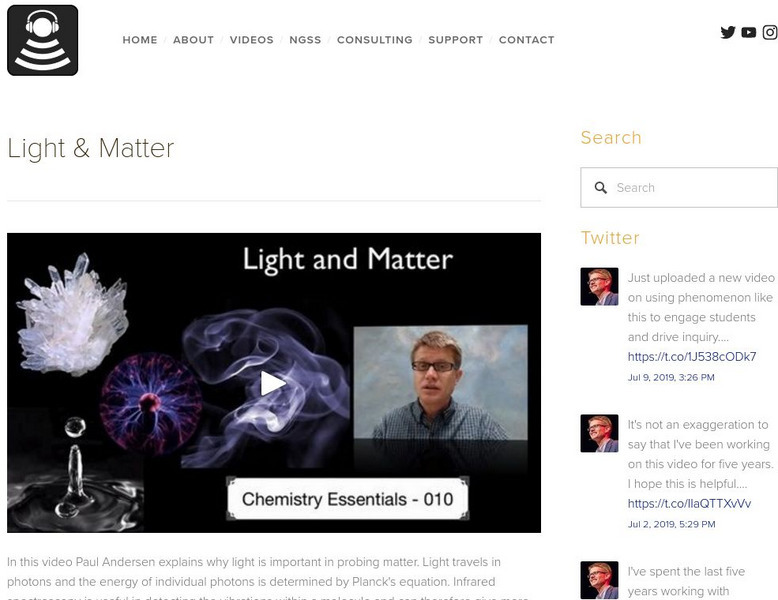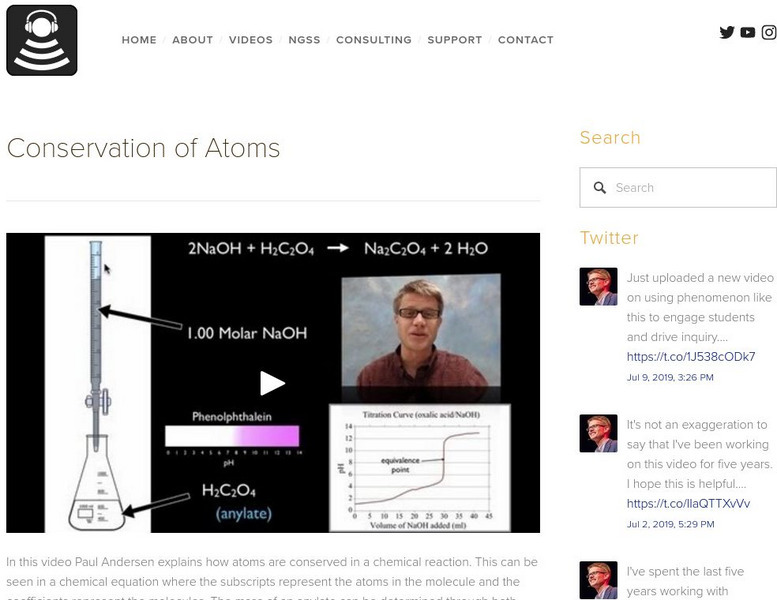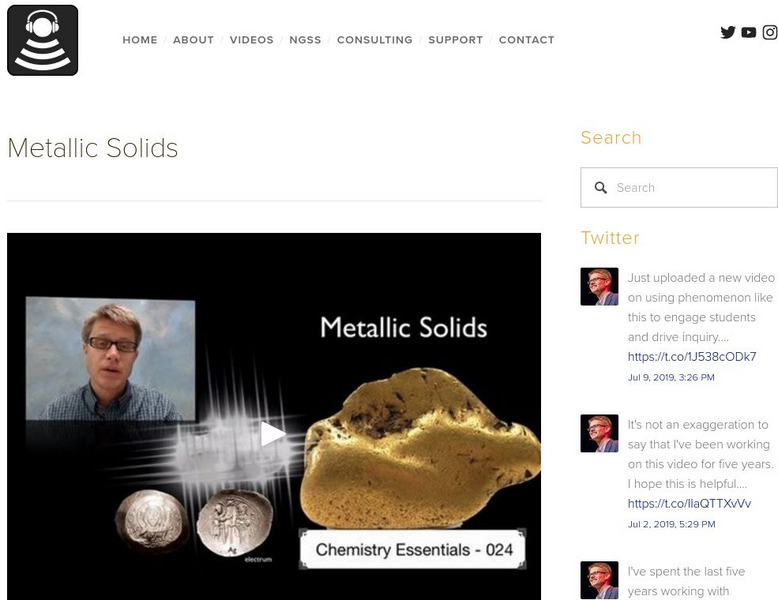Hi, what do you want to do?
Bozeman Science
Bozeman Science: Ap Chemistry: Light & Matter
In this video, Paul Andersen explains why light is important in probing matter. Light travels in photons and the energy of individual photons is determined by Planck's equation. Infrared spectroscopy is useful in detecting the vibrations...
Bozeman Science
Bozeman Science: Ap Chemistry: Symbolic Representations
Paul Andersen explains how the conservation of matter can be displayed with both symbolic representations and particulate drawings. A simple conservation of matter problem is also included.
Bozeman Science
Bozeman Science: Ap Chemistry: Conservation of Atoms
Paul Andersen explains how atoms are conserved in a chemical reaction. This can be seen in a chemical equation where the subscripts represent the atoms in the molecule and the coefficients represent the molecules. The mass of an anylate...
Bozeman Science
Bozeman Science: Ap Chemistry: Solids and Liquids
Paul Andersen compares and contrasts the properties of solids and liquids. Solids have a more organized structure which can either be amorphous or crystalline. In liquids the intermolecular forces are lower and so the molecules can show...
Bozeman Science
Bozeman Science: Ap Chemistry: Gases
Paul Andersen explains how gases differ from the other phases of matter. An ideal gas is a model that allows scientists to predict the movement of gas under varying pressure, temperature and volume. A description of both the kinetic...
Bozeman Science
Bozeman Science: Ap Chemistry: Solutions
Paul Andersen explains the important properties of solutions. A solution can be either a solid, liquid or gas but it must be homogeneous in nature. The solutes can not be separated with a filter and so either chromatography or...
Bozeman Science
Bozeman Science: Ap Chemistry: London Dispersion Forces
Paul Andersen describes the positive force intermolecular forces found between all atoms and molecules. As electrons are distributed unevenly it creates instantaneous dipoles which hold molecules together. This force even holds uncharged...
Bozeman Science
Bozeman Science: Ap Chemistry: Dipole Forces
Paul Andersen describes the intermolecular forces associated with dipoles. A dipole is a molecule that has split charge. Dipole may form associations with other dipoles, induced dipoles or ions. An important type of dipole-dipole forces...
Bozeman Science
Bozeman Science: Ap Chemistry: Intermolecular Forces
Paul Andersen explains how intermolecular forces differ from intramolecular forces. He then explains how differences in these forces account for different properties in solid, liquids and gases. Some of these properties include the...
Bozeman Science
Bozeman Science: Ap Chemistry: Covalent Bonding
Paul Andersen explains how covalent bonds for between atoms that are sharing electrons. Atoms that have the same electronegativity create nonpolar covalent bonds. The bond energy and bond length can be determined by graphing the...
Bozeman Science
Bozeman Science: Ap Chemistry: Ionic Bonding
Paul Andersen explains how ionic solids form when cations and anions are attracted. When atoms lose or gain electrons they form ions. The strength of the attraction between ions is based on the amount of charge and the distance between...
Bozeman Science
Bozeman Science: Ap Chemistry: Lewis Diagrams & Vsepr Models
Paul Andersen explains how you can use Lewis Diagrams and VSEPR Models to make predictions about molecules. The Lewis diagrams are a two-dimensional representations of covalent bonds and the VSEPR models show how the molecule could exist...
Bozeman Science
Bozeman Science: Ap Chemistry: Ionic Solids
In this video, Paul Andersen explains how ionic solids form a lattice between cations and anions. According the Coulomb's Law the lattice energy increases as the ions carry a larger charge and are smaller. Some of the properties of ionic...
Bozeman Science
Bozeman Science: Ap Chemistry: Metallic Solids
Paul Andersen explains how metallic solids form when delocalized electrons hold the positive nuclei in an electron sea. This model helps to explain the properties of metals like conductivity, shiny appearance, malleability, ductility,...
Bozeman Science
Bozeman Science: Ap Chemistry: Covalent Network Solids
Paul Andersen explains how covalent network solids form elementally (like graphite) or by combining multiple nonmetals (like quartz). Covalent network solids contain elements from the carbon group because they have four valence electrons...
Bozeman Science
Bozeman Science: Ap Chemistry: Molecular Solids
Paul Andersen describes the structure and explains the properties of molecular solids. High intramolecular forces hold electrons and reduce conductivity, whereas low intermolecular forces decrease the melting point. Important polymers...
Bozeman Science
Bozeman Science: Ap Chemistry: Chemical Equations
Paul Andersen shows you how to write balanced equations that describe chemical changes. He then gives you a short introduction to balancing equations and uses the PHET site to practice this skill. [9:39]
Bozeman Science
Bozeman Science: Ap Chemistry: Stoichiometry
Paul Andersen explains how stoichiometry can be used to quantify differences in chemical reactions. The coefficients in a balanced chemical equation express the mole proportions in that reaction. These values can be used to predict the...
Bozeman Science
Bozeman Science: Ap Chemistry: Synthesis & Decomposition Reactions
Atoms or molecules combine to form a new compound in a synthesis reaction. Examples include the addition of oxygen to magnesium metal to create magnesium oxide and the addition of carbon dioxide to water to crete carbonic acid. [4:15]
Bozeman Science
Bozeman Science: Ap Chemistry: Neutralization Reactions
In a neutralization reaction (or acid-base reaction) a proton is transferred from the Br\u00F8nsted--Lowry acid to the Br\u00F8nsted--Lowry base. Water is amphoteric and so it can serve as either an acid or a base in a neutralization...
Bozeman Science
Bozeman Science: Ap Chemistry: Redox Reactions
Paul Andersen explains how redox reactions are driven by the movement of electrons from the substance that is oxidized to the substance that is reduced. Oxidation is the loss of electrons and reduction is the gaining of electrons. [11:40]
Bozeman Science
Bozeman Science: Ap Chemistry: Chemical Change Evidence
Paul Andersen explains how chemical differs from physical change. In the laboratory macroscopic observations are used to infer changes at the particulate level. Evidence for chemical change include gas production, change in temperature,...
Bozeman Science
Bozeman Science: Ap Chemistry: Endothermic & Exothermic Reactions
In this video, Paul Andersen explains how heat can be absorbed in endothermic or released in exothermic reactions. An energy diagram can be used to show energy movements in these reactions and temperature can be used to measure them...
Bozeman Science
Bozeman Science: Ap Chemistry: Electrochemistry
Paul Andersen explains how electrochemical reactions can separate the reduction and oxidation portions of a redox reactions to generate (or consume) electricity. The half reactions can be analyzed to determine the potential of either a...




























